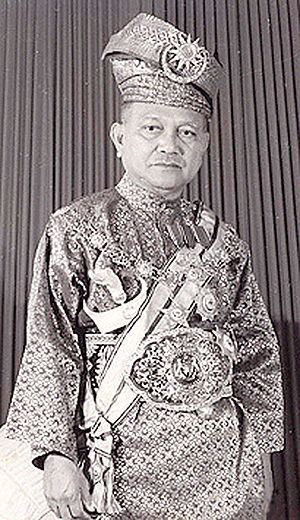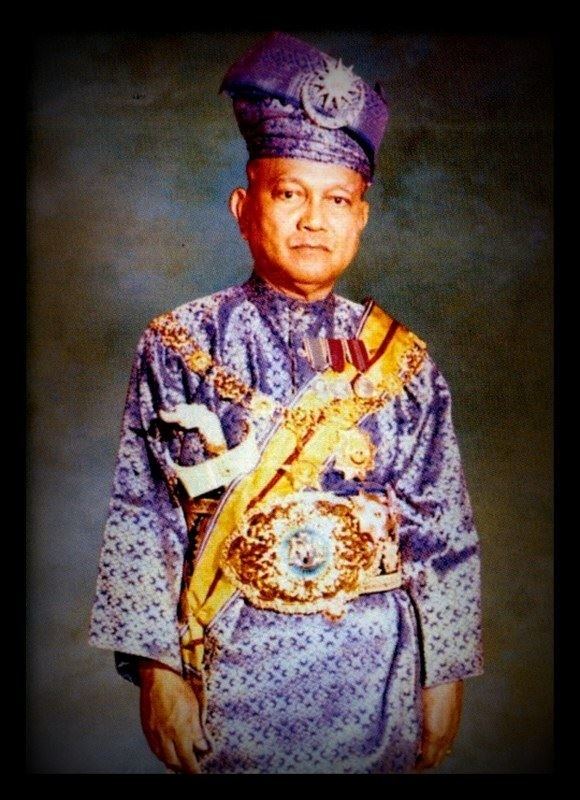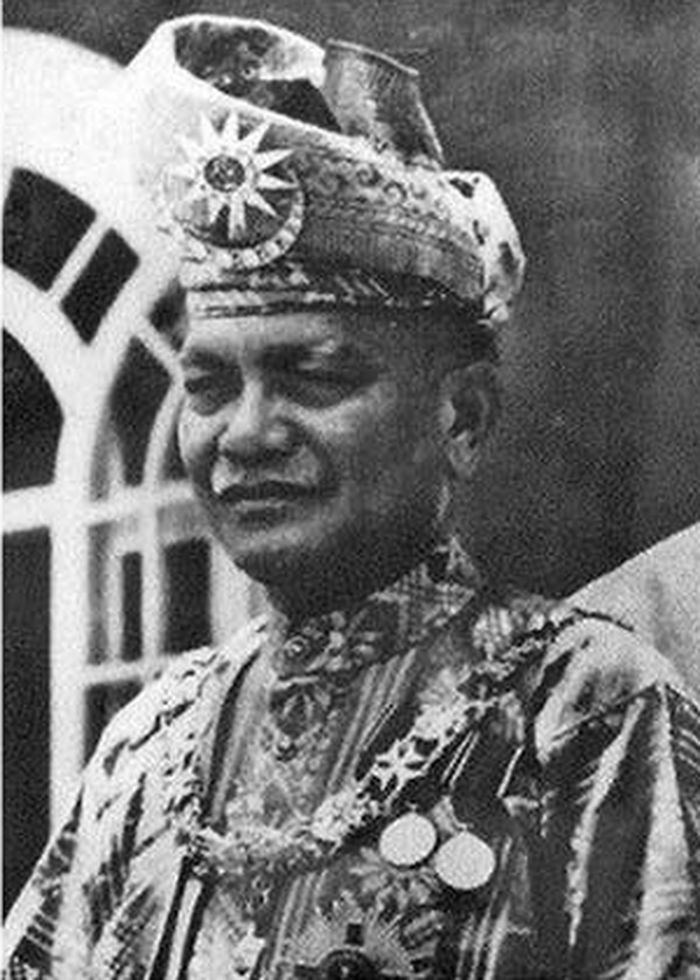Installation 2 September 1957 Role Yamtuan Besar Predecessor Position Established Spouse Tunku Kurshiah (m. 1929) | Installation 25 April 1934 Grandchildren Tunku Naquiyuddin Name Abdul of | |
 | ||
Reign 31 August 1957 – 1 April 1960 Successor Hisamuddin Alam Shah of Selangor Reign 3 August 1933 – 1 April 1960 Parents Muhammad of Negeri Sembilan Children Jaafar of Negeri Sembilan, Muhriz of Negeri Sembilan Similar People Jaafar of Negeri Sembilan, Muhriz of Negeri Sembilan, Muhammad of Negeri Sembilan, Tunku Besar Burhanuddin, Tuanku Bahiyah | ||
Tuanku Abdul Rahman ibni Almarhum Tuanku Muhammad, GCMG (24 August 1895 – 1 April 1960) was the first Supreme Head of State or Yang di-Pertuan Agong of Malaya of the Federation of Malaya, eighth Yang di-Pertuan Besar of Seri Menanti and second Yang di-Pertuan Besar of modern Negri Sembilan.
Contents
- Early career
- Election as Ruler of Negeri Sembilan
- Election as King
- Installation
- Death and funeral
- Legacy
- Belief in democracy
- Family life
- Hobbies and interests
- Honours
- References

Early career

Born Tunku Abdul Rahman at Seri Menanti on August 24, 1895, he was the second son of Tuanku Muhammad ibni Almarhum Tuanku Antah, first Yang di-Pertuan Besar of modern Negeri Sembilan and seventh Yang di-Pertuan Besar of Seri Menanti (1888–1933) by his second wife, Tunku Puan Chik.

He received his primary education at the Jempol Malay School, going on to the Malay College between 1907 and 1914. He worked at the Federal Secretariat in Kuala Lumpur for a period of one year before being appointed Assistant Collector of Land Revenue in Seremban. He served in the Malayan Volunteer Infantry as a Second Lieutenant, to be promoted Lieutenant in 1918.

On the death of his elder brother, Tunku Abdul Aziz, in 1917, he was groomed as heir to the throne and received the title of Tunku Muda Serting.

Tunku Abdul Rahman was later appointed as Assistant Malay Officer in Klang before being transferred to Sepang. He was then assigned to work in Ulu Selangor as Assistant Collector of Land Revenue. As a result of his perseverance and diligence, he was promoted to Assistant District Officer. The turning point of his career was in 1925, when he served for a short period in the Kuala Lumpur Supreme Court.
In 1925, he accompanied his father, who was then the ruler of Negeri Sembilan, on a trip to the United Kingdom for the British Empire Exhibition in Wembley and to visit His Majesty King George V. During the journey to the United Kingdom, he decided that he wanted to study law. With the approval of his father Tuanku Muhammad, Tunku Abdul Rahman stayed in the United Kingdom until he completed his studies and received a degree in law.
He stayed on to qualify as a barrister from Inner Temple. Three years later, in 1928, he was admitted to the bar. In London, he was elected first President of the Kesatuan Melayu United Kingdom, one of the earliest Malay nationalist groups.
Upon returning to Malaya in December 1928, he served in the Malayan Civil Service in various parts of the country. For the first few years, he worked hard until he became a Magistrate. Subsequently, he was appointed District Officer.
Election as Ruler of Negeri Sembilan
In 1933, following the death of his father, he succeeded him onto the throne of Negeri Sembilan. At that time, he was already an advocate, hence making him the only Malay ruler with an advocate and solicitor’s qualifications.
Tuanku Abdul Rahman (as he became) admitted to British interrogators that he had made speeches in favour of the Japanese during the latter's military occupation of Malaya (1942–1945) but this had been done under duress and that the Japanese forcibly removed certain of his royal privileges.
Although he subsequently signed the Malayan Union treaty, he repudiated it later and upon the suggestion of Sultan Badlishah of Kedah, engaged a London-based lawyer to represent the case of the Malay rulers against the Malayan Union plan of Clement Attlee's government.
Election as King
Tuanku Abdul Rahman was elected first Yang di-Pertuan Agong or Paramount Ruler of independent Malaya on 3 August 1957 for a five-year term by eight votes to one, defeating the more senior Sultan Abu Bakar of Pahang.
He had been the ruler of Negeri Sembilan for 24 years before being elected as the first Yang di-Pertuan Agong.
Installation
Tuanku Abdul Rahman was installed as the first Yang di-Pertuan Agong of independent Malaya on 4 September 1957 at the throne room of the Istana Negara.
As Malay rulers do not traditionally possess crowns, he was installed by kissing the royal kris of state (keris kerajaan) to the beat of the nobat, a tradition which has been followed by every Yang di-Pertuan Agong since.
In honour of Tuanku Abdul Rahman, all subsequent Yang di-Pertuan Agong of Malaysia have also used the headdress Dendam Tak Sudah (literally Unending Revenge), the fashion employed in Negeri Sembilan.
Death and funeral
Tuanku Abdul Rahman died in his sleep at Istana Negara in Kuala Lumpur in the early morning of 1 April 1960. The lying in state was held at the Banquet Hall of the Istana Negara. On 2 April 1960, a state funeral procession was held in Kuala Lumpur, whereupon Adbul Rahman's teak coffin was then taken by train to Seremban and later by hearse to the Istana Besar, Seri Menanti. He was buried at the Royal Mausoleum in Seri Menanti, Negeri Sembilan on 5 April 1960.
Legacy
Tuanku Abdul Rahman's portrait is still featured on the obverse of Malaysian Ringgit banknotes since the First series which was issued in 1967 till present day.
Belief in democracy
Tuanku Abdul Rahman believed strongly in parliamentary democracy and one of his most memorable quotes was to a foreign dignitary from the Middle East who in 1959 complained about Prime Minister Tunku Abdul Rahman Putra Al-Haj's "high handed" manner and wanted the King to sack him. To this, the King replied: "Alas I can't sack him; he is elected by the people, and as Prime Minister of the country he can sack me!"
Family life
Tuanku Abdul Rahman married four times. His marriages were:
- in 1919 to Dulcie Campbell, a Eurasian nurse who embraced Islam as Cik Maimunah (divorced)
- in 1920 to Tunku Maharun binti Tunku Mambang, a member of the Negeri Sembilan royal family (divorced)
- in 1929 to Tunku Kurshiah binti Tunku Besar Burhanuddin, a cousin, who became first Raja Permaisuri Agong or Queen of Malaya
- in 1948 to Tunku Zaidah binti Tunku Zakaria (1922–present), another cousin
Tuanku Abdul Rahman has three sons and five daughters. His second wife, Tuanku Maharum gave birth first to a boy, Tuanku Munawir, the ninth Yang di-Pertuan Besar of Negeri Sembilan. Cik Engku Maimunah, his first wife, gave birth to two boys and two girls. The eldest is Tunku Aidah, followed by Tuanku Jaafar (the tenth Yang di-Pertuan Besar of Negeri Sembilan), Tunku Sheilah and Tunku Abdullah.
Two of his children succeeded him as Yang di-Pertuan Besar of Negeri Sembilan:
- Tuanku Munawir (son of Tunku Maharun), who reigned 1960–1967
- Tuanku Ja'afar (son of Dulcie Campbell), who succeeded his brother in 1967 and reigned till 27 December 2008
His grandson Tuanku Muhriz currently reigns as Yang di-Pertuan Besar of Negeri Sembilan.
Hobbies and interests
Tuanku Abdul Rahman had a keen interest in sports such as cricket, football and tennis. However, his favourite sport was boxing. In fact, when he was young, he loved wearing boxing gloves to box with his sons.
